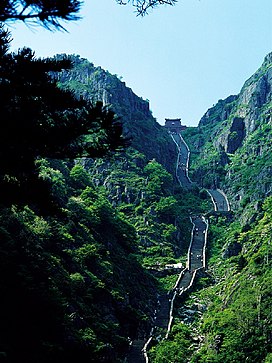
Back جبل تاي Arabic جبل تاى ARZ Monte Tai AST Gunung Tai BAN Тайшан Bulgarian তাই পর্বত Bengali/Bangla ཐའེ་ཧྲན་རི་བོ། Tibetan Mont Tai Catalan Taishan (bukid) CEB Tchaj-šan Czech
| Mount Tai | |
|---|---|
 The South Gate to Heaven at Mount Tai | |
| Highest point | |
| Elevation | 1,532.7 m (5,029 ft) |
| Prominence | 1,505 m (4,938 ft)[1] |
| Listing | Ultra |
| Coordinates | 36°15′21″N 117°06′27″E / 36.25583°N 117.10750°E[1] |
| Geography | |
| Geology | |
| Rock age | Cambrian |
| Mountain type(s) | metamorphic, sedimentary |
| Climbing | |
| Easiest route | Cable Car |
| Criteria | Cultural: i, ii, iii, iv, v, vi; Natural: vii |
| Reference | 437 |
| Inscription | 1987 (11th Session) |
| Area | 25,000 ha |
| Mount Tai | |||||||||||||||||||||||||||||||||
|---|---|---|---|---|---|---|---|---|---|---|---|---|---|---|---|---|---|---|---|---|---|---|---|---|---|---|---|---|---|---|---|---|---|
 "Mount Tai" in Chinese characters | |||||||||||||||||||||||||||||||||
| Chinese | 泰山 | ||||||||||||||||||||||||||||||||
| Literal meaning | "exalted mountain" | ||||||||||||||||||||||||||||||||
| |||||||||||||||||||||||||||||||||
| Alternative Chinese name | |||||||||||||||||||||||||||||||||
| Chinese | 岱山、岱岳、岱宗、太山、东岳 | ||||||||||||||||||||||||||||||||
| |||||||||||||||||||||||||||||||||
Mount Tai (Chinese: 泰山; pinyin: Tài Shān) is a mountain of historical and cultural significance located north of the city of Tai'an. It is the highest point in Shandong province, China. The tallest peak is the Jade Emperor Peak (simplified Chinese: 玉皇顶; traditional Chinese: 玉皇頂; pinyin: Yùhuáng Dǐng), which is commonly reported as being 1,545 meters (5,069 ft) tall.[2]
Mount Tai is known as the eastern mountain of the Sacred Mountains of China. It is associated with sunrise, birth, and renewal, and is often regarded the foremost of the five. Mount Tai has been a place of worship for at least 3,000 years and served as one of the most important ceremonial centers of China[3] during large portions of this period. Because of its sacred importance and dramatic landscape, it was made a UNESCO World Heritage Site in 1987. It meets 7 of the 10 evaluation standards of World Heritage, and is listed as a World Heritage site that meets the most standards, along with the Tasmanian Wilderness World Heritage Area in Australia.
An earthquake[4][5] or thunderstorm[6] occurred in Mount Tai in 1831 BC[4] or 1652 BC,[5] also known as Mount Tai earthquake. This event was first recorded in the Bamboo Annals, and at present, it is recognized by most scholars as the first recorded earthquake in Chinese history.[7][8]
- ^ a b "Central and Eastern China, Taiwan and Korea" Archived 2012-08-09 at the Wayback Machine Peaklist.org.Listed as "Tai Shan". Prominence based on an elevation of 1,545 m and a col of 40 m. Retrieved 2011-11-19.
- ^ Yuan Xingzhong; Hong, Liu (2000). "Studies on the diversity of soil animals in Taishan Mountain". Journal of Forestry Research. 11 (2): 109–113. doi:10.1007/BF02856685. S2CID 24791914. Archived from the original on 2007-09-30. Retrieved 2007-06-04.
- ^ "Mount Tai". Encyclopædia Britannica. Archived from the original on 2 February 2015. Retrieved 31 January 2015.
- ^ a b 晁洪太; 王志才; 李家灵; 崔昭文 (1999). "山东泰安地区断层的最新活动与"泰山震"". 地震地质. 21 (2): P105-114. Archived from the original on 2020-04-08. Retrieved 2020-04-28.
- ^ a b 刁颋 (2010). "夏帝发七年"泰山震"的解读". 国际地震动态. 32 (376): P36-44. Archived from the original on 2020-05-28. Retrieved 2020-04-28.
- ^ 高继宗 (2008). "夏发七年"泰山地震"考". 国际地震动态. 30 (359): P135. Archived from the original on 2020-05-28. Retrieved 2020-04-28.
- ^ 雷册渊 (2017-08-23). "中国最早的地震记录 距今4000多年" (in Simplified Chinese). 人民网. Event occurs at 17:24. Archived from the original on 2018-06-26. Retrieved 2018-06-12.
- ^ "历史钩沉:泰山地震——历史上最早记载的地震" (in Simplified Chinese). 泰安大众网. 2015-05-23. Event occurs at 14:28. Archived from the original on 2018-06-26. Retrieved 2018-06-12.


